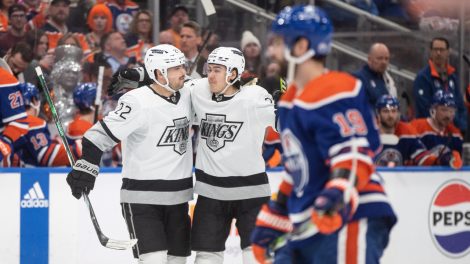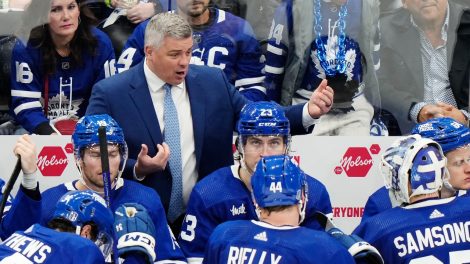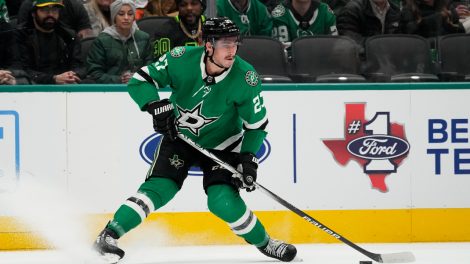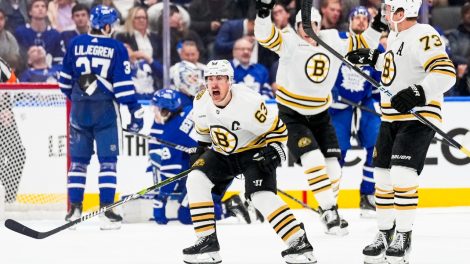Gather ’round, boys and girls, and let me tell you the tale of what might be the worst trade in Toronto Maple Leafs history.
Many younger Leafs fans tend to reference the Tuukka Rask-for-Andrew Raycroft exchange as the worst in Leafs history. As a 20-something, I’ve definitely said that a few times myself.
No doubt, that was a terrible trade. But the worst in Leafs history?
No. No, no. Older Leafs fans know where I’m going right now.

First of all, shout out to my wife for her marker board skills. She has much neater handwriting than me.
“But Steve, why are there three teams in this trade tree? Is this a three-way deal?”
Allow me to explain.
I’m sure you’ve probably figured out by now that I’m going to skewer this garbage pile of a deal. If you want to read a much more level-headed approach, Gord Stellick wrote an excellent retrospective on this deal in 2014. You should definitely read it (after, though).
Now without further delay, let’s get on with this autopsy.
THE SHORT EXPLANATION:
1. The Leafs made a risky deal with the New Jersey Devils
2. At first it looked OK for the Leafs
3. Then it looked catastrophic for the Leafs
4. The Leafs tried to fix it
5. The Leafs fixed it and made it worse at the same time
6. It got even worse somehow
THE LONG EXPLANATION:
The Leafs stunk at the beginning of the 1989-90 season. They wanted to not stink anymore. Fair, right?
In order to no longer stink, the Leafs acquired defenceman Tom Kurvers from the Devils. You’ll hear a lot of older Leafs fans lament Kurvers because of the horror-show trade I’m about to explain to you, but the fact of the matter is he was a good NHL player—and for a while, a good Leaf.
In the season before he joined Toronto, Kurvers had 16 goals and 50 assists for 66 points in 74 games with the Devils. I’ll repeat: he was a defender. Yeah, the ’80s were nuts.
After getting traded to the Leafs, who weren’t good, Kurvers had 15 goals and 37 assists for 52 points in 71 games. He was the Leafs’ second-leading scoring defender behind Al Iafrate and was almost never in the penalty box.
The Leafs improved with Kurvers, made the 1990 Stanley Cup Playoffs, and everything was great.
Oh, have I not mentioned what the Leafs traded away to get Kurvers? Silly me.
In exchange for Kurvers, the Leafs traded their first round pick in 1991 to the Devils.
“A first round pick” is always a mystery. All draft picks are, really, but we’re talking about a first here. Will it be a top-five pick or something near the start of the second round? Well, the thing about trading a first-rounder more than a year in advance is that you have no idea.
Eric Lindros wasn’t just projected to go first overall in 1991—he was getting the kind of attention reserved for special players (think Connor McDavid-type hype). Whoever finished last place in the 1990-91 season would get one of the most highly-anticipated prospects since Wayne Gretzky.
For the Devils, acquiring another first-rounder for the 1991 draft was a very alluring idea.
This is the part where I mention that current Leafs GM Lou Lamoriello was the Devils’ general manager at the time.
The Leafs improved significantly with Kurvers in the lineup, so it’s hard to blame them for assuming they wouldn’t be one of the worst teams in the league that year. I would have made the same assumption if I were them.
The Leafs had the 10th overall pick in 1990 (Drake Berehowsky) so maybe they assumed the 1991 first-rounder they sent to New Jersey would be around 10th, too. The Leafs are probably safe, right?
Toronto began the 1990-91 season with a record of 1-9-1.
This is why you don’t make panic moves, kids.
In less than one calendar year, the true cost of that temporary fix Kurvers provided the Leafs was revealed.
With all that Lindros projected to be, ignoring what we know now about his injuries all these decades later, it looked like the Leafs had unwittingly dealt to the Devils someone with the potential to be one of the greatest hockey players of all time.
So, what do you do when your team stinks but you don’t want them to stink?
Find a team that does want to stink. The Quebec Nordiques were more than happy to stink.
With both teams seeing the situation in front of them, then-Leafs GM Floyd Smith and then-Nordiques GM Pierre Page pulled off a complete sham of a deal to intentionally make the Leafs better and the Nordiques worse so that the Nordiques had a better chance of finishing in last place.
“Isn’t that just like buying and selling at the trade deadline?”
Not quite, because neither team was anywhere near a playoff spot. Oh, and the trade was made in November.
The Leafs dealt 1988 first-rounder Scott Pearson and two second round picks (one in 1991 and one in 1992) in exchange for veterans Aaron Broten, Lucien DeBlois, and Michel Petit. None of those three players were great, but they were decent enough to help make Toronto the second-worst team in the league ahead of the Nordiques.
To recap that deal, the Leafs traded two second-rounders and the sixth-overall pick from just three years prior for the privilege of finishing second-last.
Quebec finished with a pathetic 46 points in 80 games while the Leafs, who I’ll remind you actually tried not to stink as much, finished with just 57. Toronto was within striking distance but couldn’t pass the Winnipeg Jets (63 points) or the New York Islanders (60 points) in the standings.
Enough of this. Let’s rip the bandaid off.
Quebec finishes last, gets the first pick, and with that, they can select Eric Lindros. (That’s a trade tree for another day, though.)
Luckily for the Leafs, the San Jose Sharks have just joined the NHL as an expansion team and are awarded the second overall pick in 1991. With that pick, the Sharks select Pat Falloon.
Now it’s New Jersey’s turn.
I don’t know exactly how it went down, but here’s how I like to picture it:
Lamoriello slowly walks up to the podium, stoic as ever, before making accidental eye contact with those sitting at the Leafs’ table before doubling over in a fit of crying-laughing. After four or five minutes of that, he does his absolute best to get up off the floor and announce his team’s selection.
“The New Jersey De-HAAAAAAAHAHA. OK, OK… OK… Sorry. Woo. OK. The New Jersey Devils are proud the sele- I seriously can’t believe I’m doing this. How do we have this pick? This is hilarious! OK! No. I’m sorry. Alright. Let’s go, come on Lou, you can do this. With the third overall selection in the 1991 NHL Entry Draft—we actually have the honest-to-God third overall pick, I’m not messing with you guys—the New Jersey Devils are proud to select…”
Scott Niedermayer.
The Leafs recently released their Top 100 players list. If they hold on to their first round pick and draft Niedermayer, where do you think he would fall on that list? (Borje Salming is eighth, by the way.)
1,263 games played. 172 goals. 568 assists. 740 points. Another 98 points in 202 playoff games. A Norris Trophy as the NHL’s best defender in 2004. I’d mention his four Stanley Cups and a Conn Smythe, too, but we’re trying to envision him on the Leafs, here.
Here’s another for the “ifs and buts” file: If the Leafs had drafted Niedermayer and then still managed to pull off all the crazy Doug Gilmour and Dave Andreychuk trades they made in 1992 and 1993, do the Leafs beat the Los Angeles Kings in the Conference Final in 1993, then defeat the Montreal Canadiens in a Toronto-Montreal Stanley Cup Final and become champions?
What about the following year, in 1994? Would the Leafs have beaten the Vancouver Canucks in the Conference Final and gone on to top the New York Rangers for back-to-back Stanley Cups?
The Leafs tried to prevent the Devils from getting a Hockey Hall of Fame-worthy player with their pick. In doing so, the Leafs took one Hall of Fame player away from the Devils and handed them another who was arguably better.
Niedermayer played 132 more games with the Devils alone than Lindros played in his entire career. For added irony, Lindros’ career was shortened partly due to the crushing hits of Niedermayer’s defence partner, Scott Stevens.
Oh! Kurvers. I almost forgot.
Kurvers had no goals and just three assists in 19 miserable games with the miserable 1990-91 Leafs before getting traded to the Vancouver Canucks for Brian Bradley.
Here’s where the Hockey Gods are just messing with the Leafs.
Kurvers turned right back into the Kurvers of old—maybe even better—the second he got to Vancouver. With four goals and 23 assists for 27 points in 32 games, Kurvers was nearly at a point-per-game click with the Canucks—as a defender!
Prior to this deal, Bradley had 11 goals and 20 assists for 31 points in 44 games in Vancouver.
Pretty good, right?
Well, Bradley came to Toronto and put up no goals and 11 assists in 26 games. He would bounce back a bit the following season, posting 31 points in 59 games. Then on June 18, 1992, some new team called the Tampa Bay Lightning claimed Bradley in the 1992 expansion draft. Bradley went on to score 300 points in 328 games with the Lightning, including a 42-goal campaign just one season after getting claimed from Toronto.
You simply can’t make this stuff up.
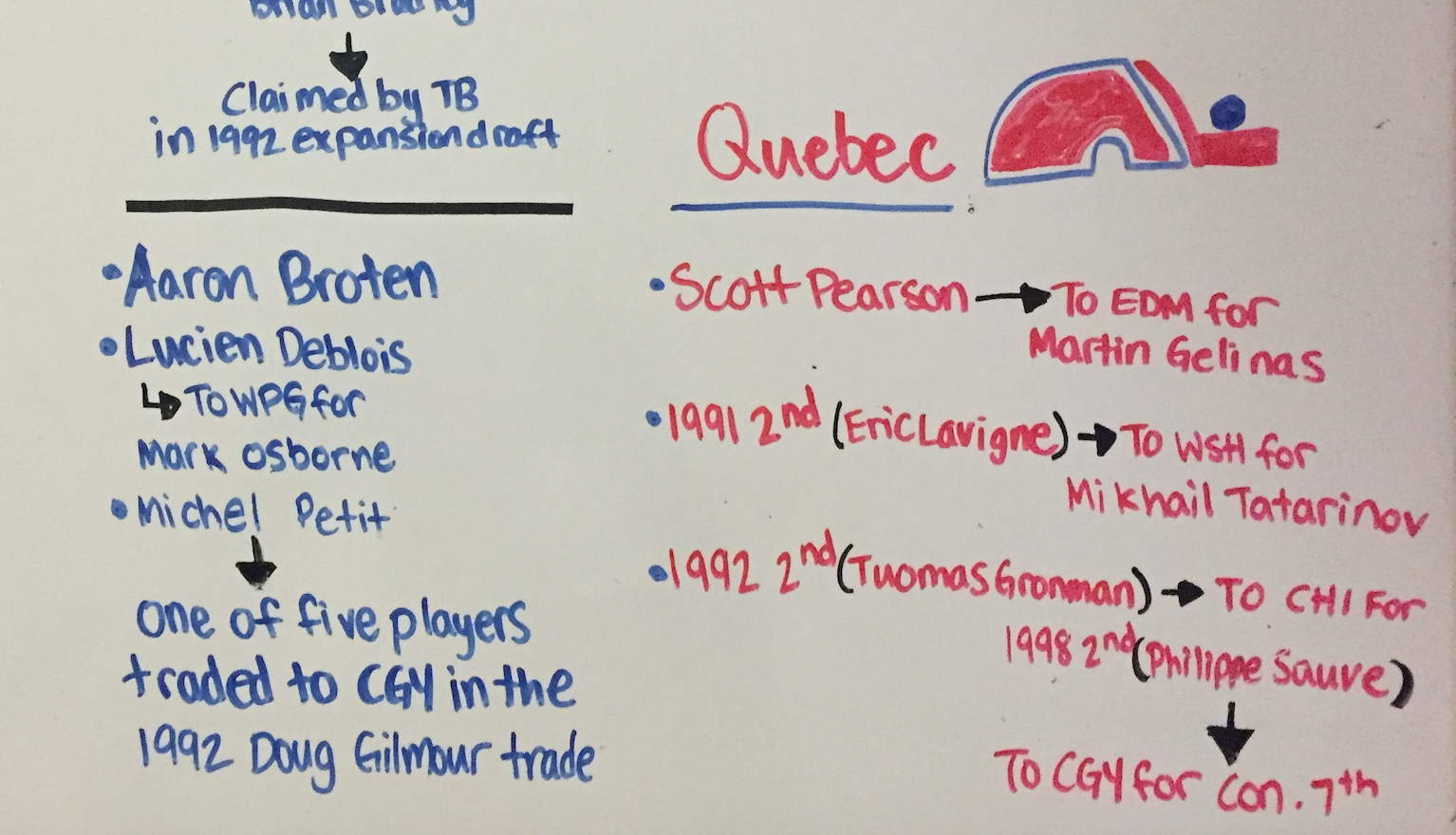
Looking at Quebec’s side-story to all this, the Leafs were fortunate to not look too foolish there. Scott Pearson wasn’t a huge impact player and Martin Gelinas, for whom Pearson was later traded, wasn’t in Quebec for long. The Nordiques were able to parlay that deal into some temporarily useful players and so were the Leafs.
Still, that doesn’t erase the fact that the reason behind this deal was the hockey equivalent of the famous chocolate factory scene from I Love Lucy.
There are similarities between the Niedermayer-Kurvers deal and the trade that brought Phil Kessel to Toronto. In both deals, the Leafs bet on themselves, traded their first-rounder for a good player way in advance, but then had a horrible start to the season and finished second-last.
People bemoan Kessel, but he led the Leafs in scoring for over half a decade. Kurvers never even played a full season in Toronto.
In terms of bad deals, this trade has everything: a risky bet that went horribly wrong, a clumsy attempt to fix the mistake that only ends up backfiring. And the Brian Bradley part of the story just adds salt to the Leafs’ wounds.
There is only one Leafs trade I’ve seen that I would consider to be as bad, if not worse, than this one.
(I’ll let your imagination figure out which deal that was before I write about it one day.)
Feel free to repay the favour to Leafs Nation, Lou.





